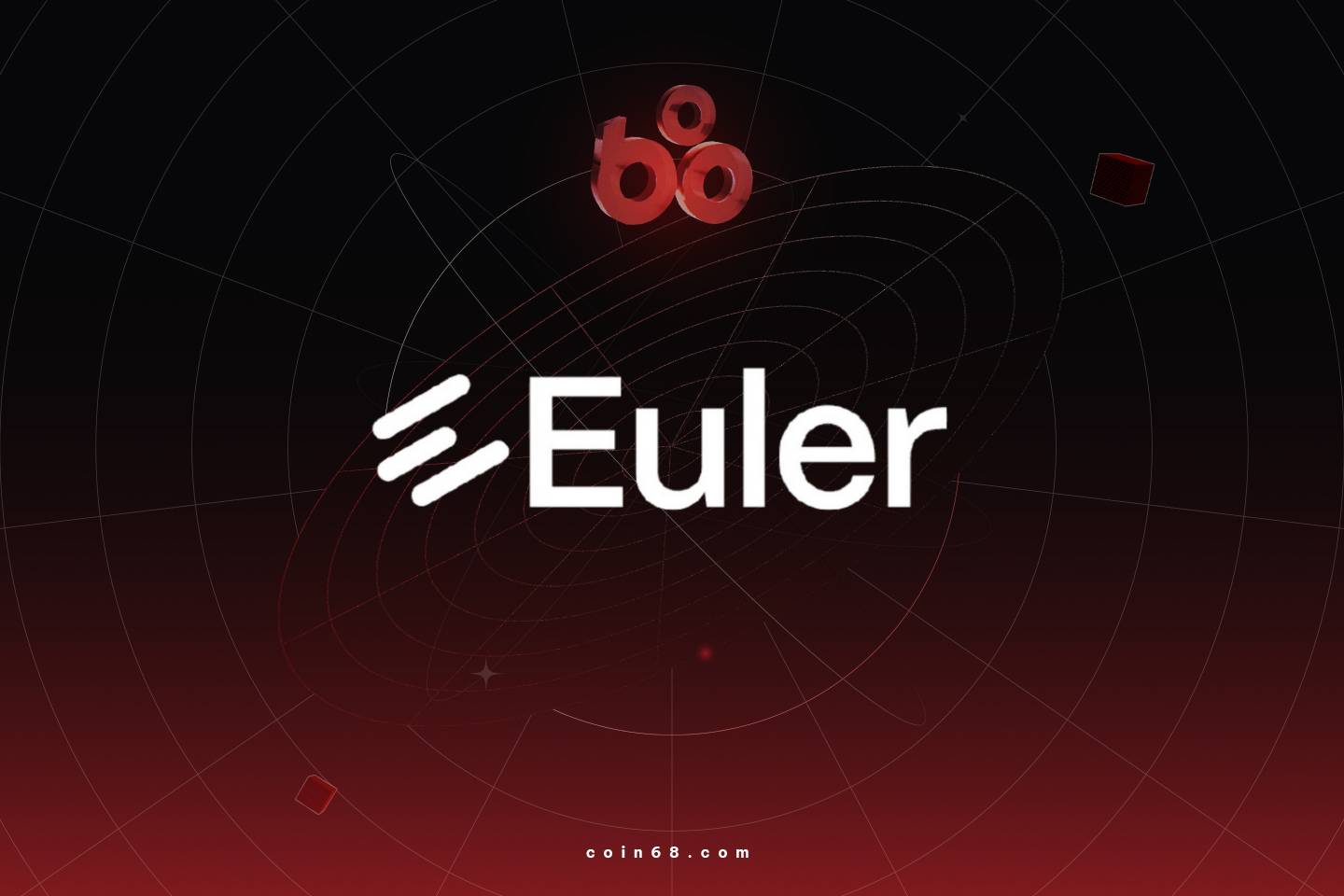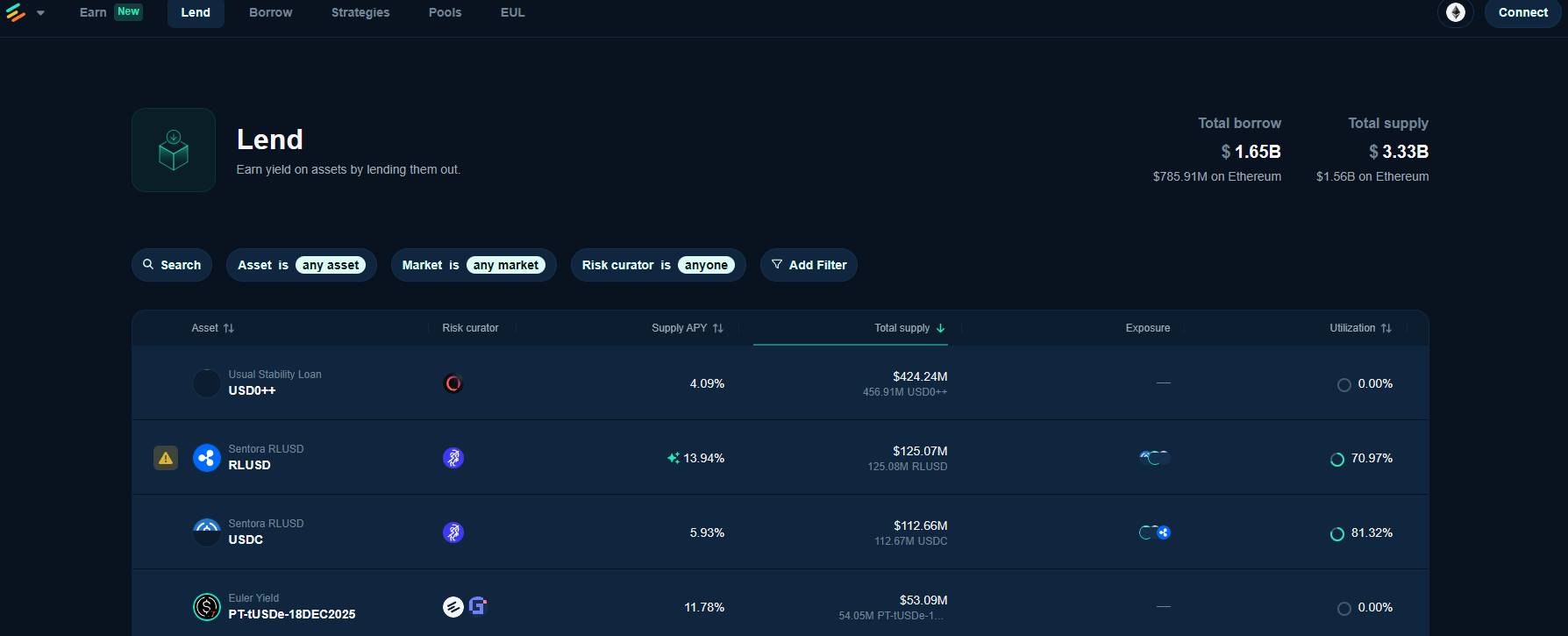Euler Finance is a decentralized lending protocol (DeFi lending protocol) on Ethereum, allowing users to lend, borrow and swap assets securely and without intermediaries. The upgraded Euler V2 version has a modular, flexible and Capital efficient architecture, allowing the creation of custom lending markets for any ERC-20 Token . So what is special about Euler Finance? Let's learn about the Lending Super App project with Coin68 through the article below!

What is Euler Finance? Lending Super App Project
What is Euler Finance?
Euler is a decentralized lending protocol that allows users to deposit crypto assets to earn interest, or borrow other assets without going through an intermediary. The protocol operates entirely on Ethereum and EVM- compatible networks, with the goal of creating an open, secure, and Capital efficient lending system.
Euler Finance
What's special about Euler Finance?
The highlight of Euler V2 – the latest version – is its modular architecture, which allows anyone to create isolated lending markets for each ERC-20 Token . This prevents the risk of one asset from spreading across the entire system, providing better protection for users. Each “vault” in Euler acts as a separate lending pool where users can deposit, borrow, or use assets as collateral flexibly.
Euler also integrates many advanced technologies such as Ethereum Vault Connector (EVC) – a central coordinator that allows vaults to securely interact with each other, and Interest Rate Models (IRM) – a model that automatically adjusts interest rates according to market supply and demand. All combined with an independent price oracle system to ensure accurate pricing and transparent liquidation.
Thanks to this design, Euler not only brings high customization, security and Capital efficiency, but also opens up new directions for DeFi applications, where users and developers can build their own lending markets to suit their own needs.
Features of Euler Finance
 Euler Finance activity page
Euler Finance activity page
- Decentralized and permissionless lending protocol : Euler allows anyone to lend, borrow or swap crypto assets directly on chain , without relying on intermediaries or access restrictions. Thanks to its permissionless mechanism, users can easily participate and deploy new credit markets flexibly.
- Modular Architecture and Vault Kit (EVK) : At the core of Euler V2 lies the EVK toolkit, which enables developers to create isolated and customized lending markets for almost any ERC-20 Token . This modular design isolates risk between markets, allowing each vault to operate independently without affecting the rest of the system.
- Vaults : Each vault acts as a separate lending pool where users can deposit Token to earn interest or use them as collateral to borrow from other vaults. Vaults can be flexibly combined to form complex structures such as cross-collateralized markets, helping to optimize Capital efficiency.
- Ethereum Vault Connector (EVC) : Vai as the “central brain” of the protocol, EVC allows vaults to securely interact with each other, allowing users to borrow from one vault using collateral in another vault. EVC also supports the creation of multiple sub-accounts for the same wallet, helping users isolate positions and better manage risk.
- Dynamic Interest Rate Models (IRM) : Euler applies intelligent interest rate models that automatically adjust according to the Capital usage level of each vault. When the usage level increases, the borrowing interest rate also increases accordingly to encourage liquidation balance and protect depositors.
- Yield and protocol fee mechanism : Depositors can receive different types of yields, including lending interest, Staking rewards, or incentives from EUL Token . 10% of the total lending interest is set aside as a fee, Chia equally between the Euler DAO and the vault administrator. Accumulated fees are processed through the Fee Flow mechanism, an open-source auction module that redistributes fees to the DAO treasury.
- Reward EUL and reward mechanism : Euler uses rEUL, a locked form of EUL, to reward early adopters. This Token unlocks gradually over 6 months at a 1:1 ratio, incentivizing long-term participation and reducing selling pressure at launch.
- Risk management and liquidation mechanism : Euler applies an automatic liquidation mechanism to ensure that the system always maintains its solvency. If a loan lacks collateral, the liquidator can buy back the asset at a discount, while the remaining bad debt is socialized among depositors in the same vault.
- Flexible Oracles : Euler supports multiple price data sources through an oracle-agnostic design, compatible with providers such as Chainlink, Pyth or Redstone. This helps the protocol ensure accuracy, reduce dependency risks and flexibly scale to each asset type.
- Hooks : Allows vault administrators to add custom rules and logic before actions like deposits, loans, or payments are performed. This allows each vault to be tailored to specific goals, from Pause Guardian to rate-limiting or applying Flash Loan fees.
- EulerSwap : EulerSwap is a DEX that is directly integrated with Euler's lending infrastructure, allowing users to swap assets within the lending ecosystem. Thanks to the Unified Liquidation model, the same asset can be used for lending, trading, and collateral, optimizing Capital efficiency across the network.
- Sub-accounts and Operators : Users can create up to 256 sub-accounts within the same wallet, allowing for segregation of positions and risk between loans. They can also authorize operators (bots or external smart contracts) to perform automated actions such as stop-loss, rebalancing, or closing positions.
- Batching and Atomic Swaps : Euler allows multiple actions (like Borrow → Swap → Deposit) to be combined in a single transaction, saving gas and allowing complex strategies to be executed atomically, without interruption.
Project Token details
EUL Token Specifications
Project name | Euler |
Ticker | EUL |
Blockchain | BNB Chain |
Contract | 0x2117e8b79e8e176a670c9fcf945d4348556bffad |
Total supply | 27,182,818 EUL |
Circulating supply | 18,685,530 EUL |
EUL Token Allocation
Strategic Partners: 39.5%
Euler DAO & Users: 34%
Euler Labs: 26.5%
Euler Foundation: 3%
Uses of EUL Token
- Governance : Allows EUL holders to vote and participate in managing protocol decisions.
- Treasury Management : Used to control and allocate funds of Euler DAO.
- Fee Flow Auction : Is the main Token in the protocol's revenue conversion auctions to EUL.
- Rewards : Distributed to users who participate in lending or borrowing, in the form of EUL or rEUL.
- Burn mechanism : A portion of EUL is burned when users unlock rEUL early, helping to reduce supply.
- Chain support : EUL uses the Omnichain Fungible Token (OFT) standard to move flexibly between blockchains.
EUL Development Roadmap
Currently, the development roadmap of the Euler project has not been announced. Coin68 will update immediately if there is detailed information.
Project Euler development team
Currently, the development team of the Euler project has not been announced. Coin68 will update immediately if there is detailed information.
Investors in the Euler project
Investors in Euler
Summary
Above is all the information about the Euler project, Coin68 hopes that readers will grasp the basic information to better understand the project and how it works. Hope you have more useful knowledge!
Note: The information in the article is not XEM investment advice, Coin68 is not responsible for any of your decisions.








